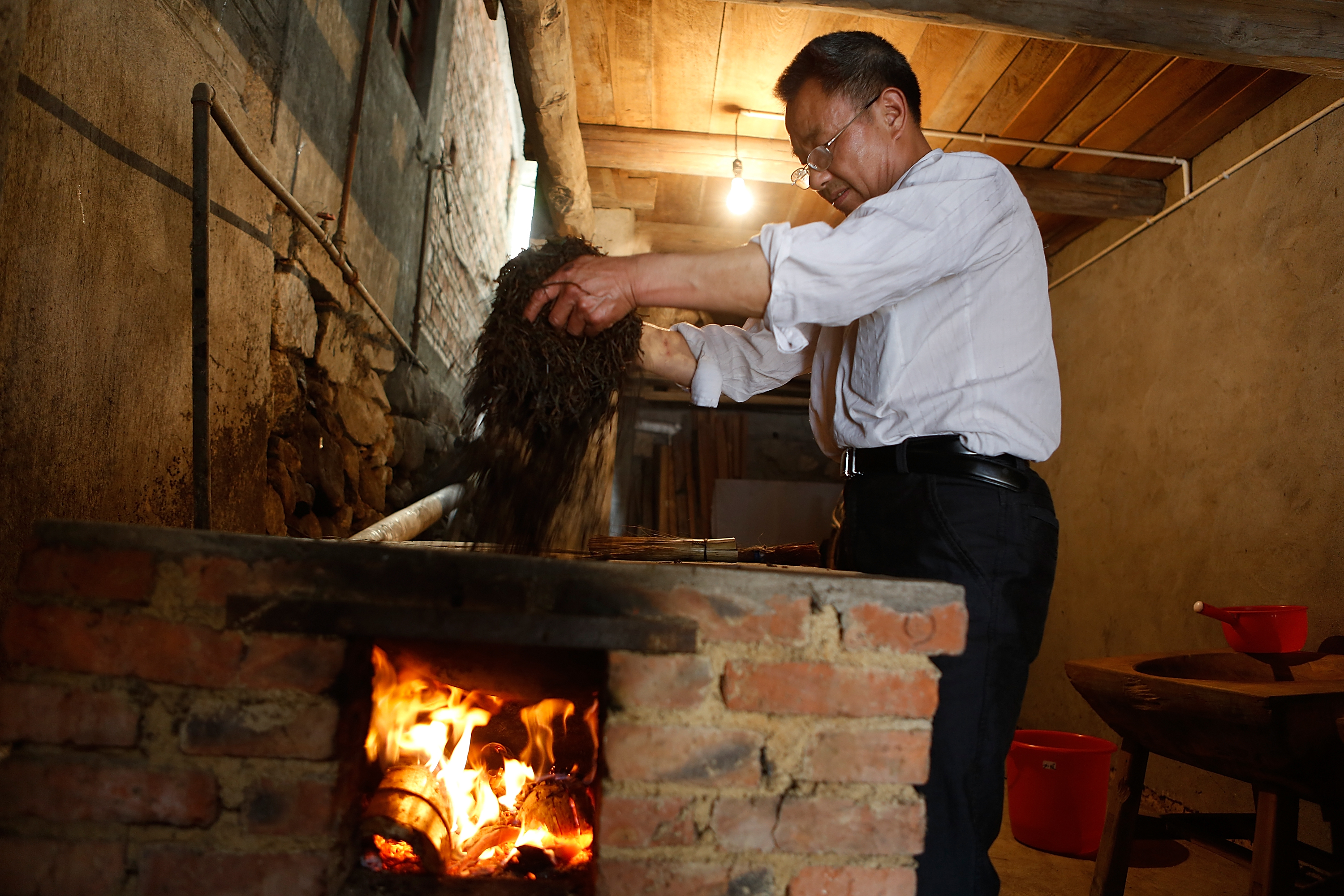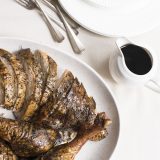The back streets of Chengdu, the capital of Sichuan province in western China, are an unlikely place for a radical reboot of the Thanksgiving turkey.
Turn this way and you’ll inhale a snoutful of preposterously spicy hotpot steam that will steal your breath and double you over. Turn that way, and tiny, flappy hongyou chaoshou (red oil dumplings) are piled in heaping bowls, irresistible and fiery. Next restaurant down, even bigger bowls of fish fillets swim in steaming scarlet oil and garlic.
There’s spice, of course. There’s vinegar. Bitter offsets sweet at every turn. And permeating it all, street after delicious street, is the distinct smell and taste of mala—the numbing combination of red chilies and Sichuan peppercorns that give so much of the regional cuisine its unique, numbing oomph. Very few things you’ll eat there have only one taste; instead, they tend to be mobs of flavors, charging your mouth.
These are not the flavors of the American Thanksgiving. But peel back the brashness and you find another, more subtle layer, the truth of this cuisine—boldness balanced. Sharp notes partner with sweet. Acids are tamed with smoke.
It was here that we discovered the flavors that would imbue our bird with nuance. Deeply savory, lightly sweet. Rich, but not overbearing. At once other, yet utterly familiar.
It was Thanksgiving weekend 2003 that I visited Chengdu, chiefly to eat. I tried to chat with a waitress named Niu Ming about whether chopsticks caused wrist problems. She indulged me for a moment, but quickly changed the subject.
“You’re here for Sichuan food,” she said, “but it doesn’t sound like you’ve ordered the best Sichuan dish there is.”
That, she assured me, is tea-smoked duck.
Tea turns up surprisingly often in Sichuan cooking. Beef filets and green tea, served in a Beijing restaurant, was one of my favorites. But I had never tried tea-smoked duck. To try it, I needed to move up the street, to a restaurant that specialized in it and, a sign told me, had a centuries-old tea-smoked duck recipe that had been carefully passed down.
What I found was unlike anything I’d ever tasted—tender, wok-smoked, with notes of caramel, camphor and even sweet Southern barbecue offsetting the sharp flavor of huajiao, or Sichuan peppercorns. It had been finished off in a fryer, so it had that crackly taste and feeling about it, too. It was so rich, so deeply flavorful that it was the only meal during that trip that I simply couldn’t finish.
It’s hard to nail down the precise origins of tea-smoked duck, though it’s usually associated with special occasions. Smoking is a popular method of preparing food in Sichuan—for preservation, initially, but these days it’s more about deliciousness. In other Sichuan restaurants, I’ve been told that tea-smoking is at least 300 years old—an assertion supported by the bragging of the restaurant I visited—and probably older. It is a well-improvised dish with many variations.
Sichuan peppercorns are a must in traditional versions of the duck, but the type of tea itself seems to be malleable. I’ve had the dish made using plain black tea (or red tea, as it’s called in China because of the color of its liquid), smoky lapsang suchong and even, once, green jasmine tea. Whatever leaves are used, they imbue the bird with an aromatic, sometimes slightly sweet flavor that's both subtle and utterly identifiable. That tea, coupled with the peppercorns, camphor twigs and fire, is said to produce the unique taste.
But could these flavors be transposed to another continent, another bird? Finding the answer was a challenge at every step.
The clean, smoky flavor of our Thanksgiving turkey comes from lapsang souchong, a traditional smoked tea from China's Fujian Province.
Lapsang comes in two varieties: original and export-grade. Both are smoked, but the export-grade—the kind most widely available in the U.S.—is made by hot-smoking readymade black tea. Original lapsang uses fresh-picked leaves, typically oolong, that wither and dry while being cold-smoked, taking on a subtler smoke flavor.
The smoking process is similar to that of ham or salmon, according to Robert Heiss of online retailer Tea Trekker. Heiss is a rare foreign witness to the making of lapsang. He was permitted to travel deep into the Wuyi mountains to see the fields where the leaves are plucked and the sheds in which they are smoked.
The wooden sheds are three stories tall. Heiss compares them to rustic tobacco-drying barns found in the American South. The sheds are divided into chambers that share an air passageway which draws smoke through the entire building.
A blend of wood (bamboo, pine and hardwood) is used to smoke the tea. The worker controlling the firebox must be judicious in coordinating proper timing with the right amount of smoke. Original-style lapsang takes 24 to 48 hours to wither and dry, but it isn't smoked for that duration. Export-grade requires less time—four to six hours—but takes on more smoke because the black tea is smoked at a higher temperature.
Export-grade lapsang's potent aroma and flavor make it especially good for cooking. It's a common ingredient for tea-smoking eggs, but it also turns up in spice rubs, fish preparations, even ice cream.
Tea-smoked duck traditionally is cooked in a wok. Fine for a 5-pound duck; impractical for a 12-pound turkey. Moving the process to a roasting pan made sense. But woks heat over intense flames, making it easy to smoke the tea.
In our roasting pan—no matter how hot the oven, no matter how tightly we wrapped pan and bird with foil—the lapsang suchong tea we scattered over the bottom never produced sufficient smoke to flavor the turkey, particularly the top. Even trying to ignite the leaves first on the stovetop proved insufficient.
That's when we wondered if perhaps the smoke didn't matter. What we wanted was the flavor of the tea. Did it really need to come from smoke? The solution was drawn from Southern barbecue—using the tea as part of a simple dry rub. Rubbing this mixture under and over the skin worked wonderfully, delivering rich, yet subtle flavors that shocked us with how well they paired with the classic Thanksgiving sides. And so much easier than smoking.

Next, the skin. The duck I ate in Chengdu had the sort of enviably crackling crisp skin we crave on turkeys. That's because it was fried. But frying is only one way to get crispy skin. The other is by removing moisture. If poultry skin is wet when it goes in the oven, it steams, hindering crisping. Patting it dry is a start, but we got the best results by letting the seasoned bird dry uncovered in the refrigerator overnight.
We liked it, but a couple things still were missing. The tea was hitting all the right savory-smoky notes, but it needed balance. It also needed color. Face it—we've come to fetishize the bronzed bird. Our solution was inspired by another Chinese duck recipe—Peking duck. This typically is a laborious process in which a duck is dried (for crispier skin), then roasted and glazed with a syrup.
Our method was already partway there. We just needed a syrup. Drawing on seasonal flavors, we made a glaze from maple syrup (for balance), soy sauce (for savory depth) and brewed tea (an additional layer of the smoky tea flavor we loved). Brushing this over the turkey a few times during roasting bronzed it beautifully and balanced our flavors.
How would this play on the stomach-focused streets of Chengdu? It’s savory, it’s smoky and it’s just a bit sweet—boldness balanced. I suspect it might do just fine.
Related Recipes
November-December 2017

Sign up to receive texts
Successfully signed up to receive texts!
We'll only send our very best offers - Like a $15 store credit to start.
By entering your phone number and submitting this form, you consent to receive marketing text messages (such as promotion codes and cart reminders) from Christopher Kimball's Milk Street at the number provided, including messages sent by autodialer. Consent is not a condition of any purchase. Message and data rates may apply. Message frequency varies. You can unsubscribe at any time by replying STOP or clicking the unsubscribe link (where available) in one of our messages. View our Privacy Policy and Terms of Service.



